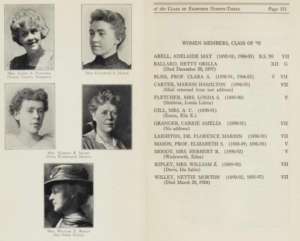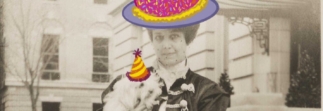
The women of the MIT class of 1893
“The questions asked in your circular letter are such as to discourage those who cannot name positions of trust, business enterprises or recent publications.”
– Mrs. Annie Ware Sabine Siebert, Class of ‘88 (p.112)
This admonishment appears to explain the lack of detail for women who attended MIT in the class records for 1888 and 1889. The Class Record of ‘88, The fourth book of the Class of Eighty-Nine, and the Thirtieth anniversary report for the class of 1893 were each digitized and made publicly available by the MIT Libraries in celebration of Public Domain Day 2020. They allow us to look back and discover what earlier attendees did after they left MIT. Yet, for women, these records often tell a different story.
When one thinks of women in the early days at MIT, they generally think of Ellen Swallow Richards, who was the first woman to graduate from MIT in 1873. In 1875, Richards established the Women’s Laboratory, where between 1876 and 1883 she instructed over 500 students. In 1882, MIT officially began admitting women to all departments, and between 1881 and 1890, more than one hundred women enrolled as students—19 earned SB degrees. These class records illustrate their increasing attendance, but also offer us a glimpse into who these women were.
Indeed, as Mrs. Siebert noted, the questions the Class of ‘88 were asked produced varying responses. There are some women with brief entries—all noticeably shorter than many of their male peers. Some, such as Mary Hutcheson Page, discuss their work around suffrage. Others, like Marion Talbot and Anne Graham Rockfellow, we know a great deal more about thanks to their work after MIT. For example, Talbot helped to found the American Association of University Women with Ellen Swallow Richards.
The fourth book of the Class of Eighty-Nine is a departure in format, declaring its deliberations “short, and without the assistance of an efficiency expert, they reach conclusions and get results” (p. 3). Rather than including notes of its members, it provides an overview of a recent annual dinner and a list of the members and their last known location.
It is interesting then that the Thirtieth anniversary report for the class of 1893 is almost a synthesis of the two earlier class books, providing an overview of their reunion as well as a compilation of class notes. The number of women in the class is greater and their notes more rich in detail. Efforts were made to include the records of those who had passed, including one memorable note for Nettie Morton Willey.
Willey, while not a graduate of the Institute, attended classes between 1890-92 and 1893-97 before becoming a chemistry teacher at Peabody High School, where she would teach for 25 years before passing. Willey helped found the MIT Women’s Association, renamed in 1964 to the Association of MIT Alumnae (AMITA), serving as its secretary and as part of the executive committee. However, the crux of her note, which was submitted by another MIT alumna, emphasizes the lasting friendships she built through MIT, declaring her as having “[a] fellowship with hearts [t]o keep and cultivate” (p. 315). This note seemingly defies exactly what Mrs. Siebert rallied against in her note for the Class of ‘88 record, illustrating that there are traits that go beyond the positions of trust, business enterprises and recent publications, yet are equally deserving of attention. The evolution of the notes over this five year period speaks to this shift in perspective, subtle as it may be, and it is one that allows us to learn more about the women of MIT, both personally and professionally.
This post was written for Public Domain Day 2020 by Alex McGee, Women@MIT Project Archivist

